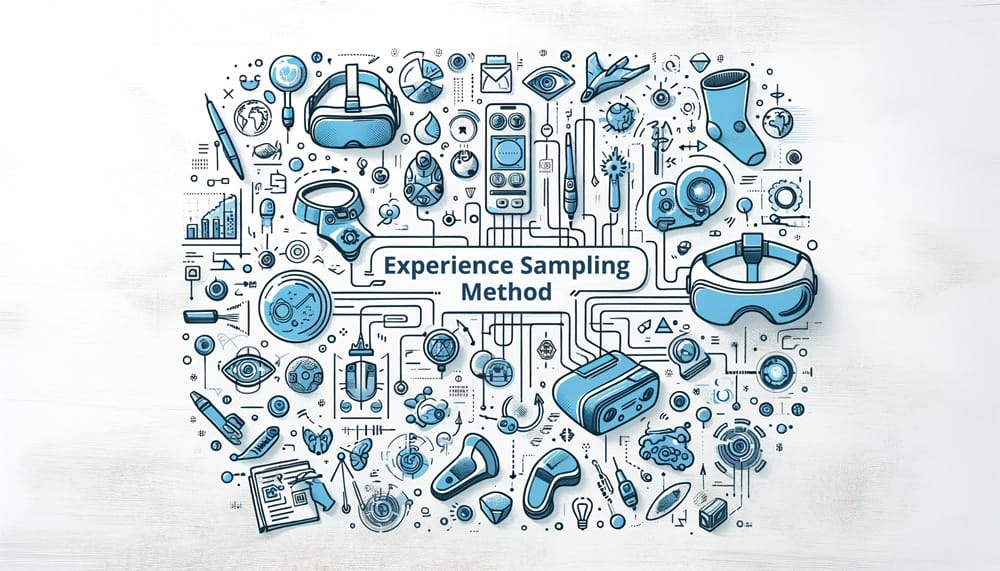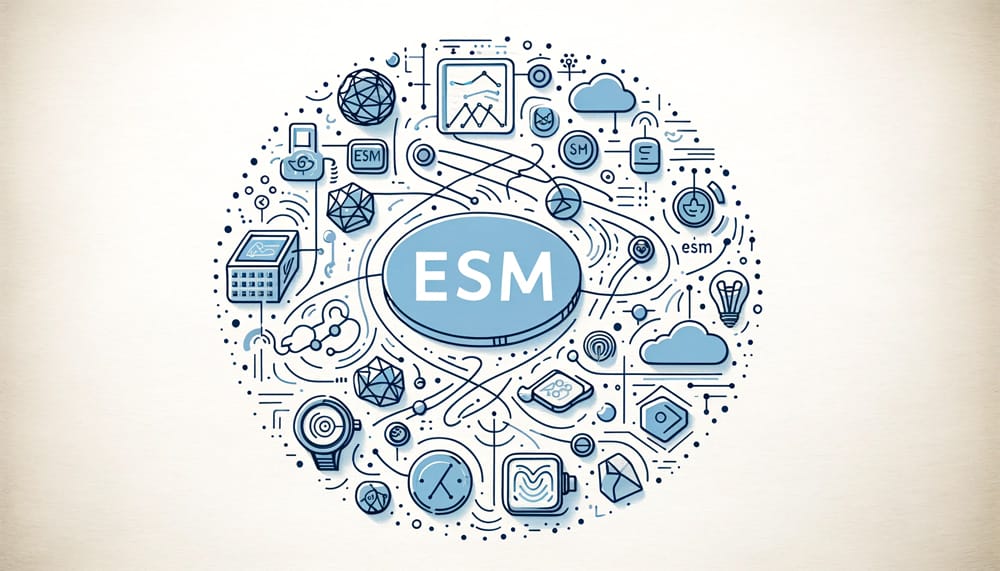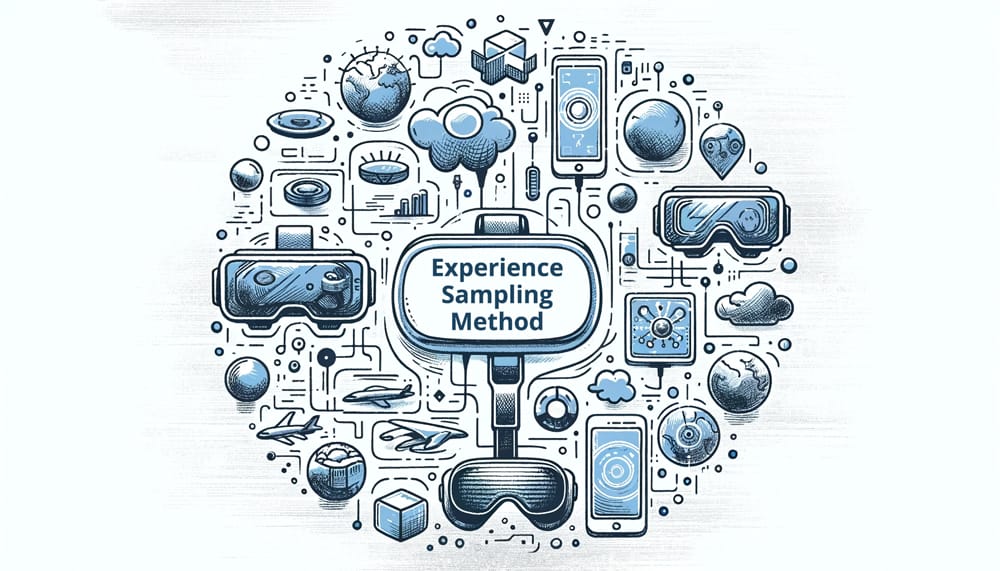Introduction to Future Trends in ESM
The landscape of Experience Sampling Method (ESM) research is continually evolving, shaped by advancements in technology and shifts in research methodologies. As we step into the future, it’s pivotal to recognize and adapt to these changes, ensuring that ESM remains a powerful tool for understanding human experiences in real time. For further insights into the foundational aspects of ESM, Introduction to Experience Sampling Method (ESM) provides a comprehensive overview.
Overview of the Evolving Landscape of ESM Research
ESM, traditionally used to capture momentary experiences and thoughts, is undergoing a transformation, influenced by emerging technologies and innovative approaches:
- Technological Integration: Recent years have seen a surge in integrating cutting-edge technologies into ESM research. This includes the use of AI and machine learning for data analysis, wearable devices for physiological data collection, and the incorporation of big data approaches.
- Enhanced Data Collection: The advent of new technologies is revolutionizing how data is collected, processed, and analyzed in ESM studies. Tools like wearable devices and mobile apps are becoming more sophisticated, offering richer and more accurate data collection methods.
- Expanding Research Horizons: ESM is being applied in increasingly diverse fields, reflecting its versatility and adaptability to various research needs. Explore the effective integration of the Experience Sampling Method (ESM) with other research methodologies in our comprehensive guide, Combining Experience Sampling Method (ESM) with Other Research Methods: A How-To Guide. This guide provides practical advice and strategies for researchers looking to enhance their studies by combining ESM with qualitative and quantitative approaches.
The Importance of Staying Abreast with Emerging Trends and Technologies

-
- Keeping Pace with Innovation: Staying updated with these advancements is crucial for researchers to leverage the full potential of ESM. Embracing new technologies can lead to more precise and comprehensive data collection and analysis.
-
- Adapting to Changing Research Dynamics: As the field evolves, so do the expectations and standards of ESM research. Researchers must adapt to these changes to ensure their work remains relevant and impactful.
-
- Ethical and Privacy Considerations: With new technologies come new ethical and privacy challenges. It’s essential to balance innovation with responsible research practices, as discussed in Ethical Considerations in ESM Research.
“In the dynamic world of ESM research, staying at the forefront of emerging trends and technologies is not just beneficial; it’s imperative for pushing the boundaries of knowledge and discovery.”
As ESM research continues to evolve, it presents exciting opportunities and challenges. Looking ahead, researchers who embrace these changes and innovate within their methodologies will lead the charge in uncovering deeper insights into human behavior and experiences.
Technological Advancements in ESM
The landscape of Experience Sampling Method (ESM) research is rapidly advancing, thanks to a plethora of technological innovations. These advancements are not only refining existing methodologies but are also opening new avenues for data collection and analysis.
Exploring Recent Technological Innovations in ESM
-
- Mobile and App-Based Technologies: The proliferation of smartphones has significantly impacted ESM research. Mobile apps have become a primary tool for data collection, offering a convenient and accessible platform for participants. This development is discussed in Technological Innovations in ESM, highlighting how app-based ESM can lead to increased participant engagement and real-time data capture.
-
- Cloud Computing and Data Storage: Cloud technologies have revolutionized data storage and processing in ESM research. With cloud computing, vast amounts of ESM data can be stored, processed, and analyzed more efficiently, as seen in the integration of big data approaches in ESM Data Visualization Techniques.
-
- Advanced Data Analytics: The integration of advanced analytical tools, including AI and machine learning, is transforming how ESM data is analyzed. These technologies allow for more sophisticated and nuanced analysis of large datasets, providing deeper insights as outlined in Analyzing ESM Data: A Guide.
Potential Impact of These Technologies on ESM Methodologies
-
- Enhanced Data Accuracy and Richness: Technologies like AI and advanced analytics can process complex ESM data more accurately, leading to richer insights. For further insights and practical tips on ESM data analysis, exploring resources like Analyzing ESM Data: A Guide can be immensely beneficial.
-
- Real-Time Data Processing: The ability to process ESM data in real-time, facilitated by mobile technology and cloud computing, allows for more immediate and dynamic research findings. For more in-depth guidance, exploring resources such as ESM Data Visualization Techniques can be incredibly beneficial.
-
- Broader Participant Reach: Mobile technologies have expanded the reach of ESM studies, allowing researchers to engage with a more diverse and widespread participant base. This inclusivity enhances the generalizability and relevance of the research.
-
- Challenges and Opportunities in Data Handling: While these technologies offer numerous advantages, they also bring challenges, particularly in managing and protecting large volumes of sensitive data. Addressing these challenges, as highlighted in Challenges and Solutions in ESM Research, is critical for ethical and effective research practices.
“The integration of cutting-edge technologies in ESM research is forging new paths for exploration, offering unprecedented opportunities for capturing and understanding the complexities of human experiences.”
These technological advancements are revolutionizing ESM research, providing tools that are more efficient, accurate, and insightful. As these technologies continue to evolve, they will undoubtedly shape the future trajectory of ESM methodologies, pushing the boundaries of what is possible in behavioral and social science research.
AI and Machine Learning in ESM

Artificial Intelligence (AI) and Machine Learning (ML) are increasingly becoming integral to Experience Sampling Method (ESM) research, offering transformative possibilities in data analysis and interpretation. Their integration into ESM is paving the way for more sophisticated and insightful research methodologies.
The Role of AI and Machine Learning in Enhancing ESM Data Analysis and Interpretation
-
- Advanced Data Analysis: AI and ML algorithms can handle the complexity and volume of ESM data with greater efficiency and accuracy. They are adept at identifying patterns and trends that might be imperceptible to human analysts.
-
- Predictive Analytics: ML models can predict future trends based on ESM data, offering valuable insights for proactive interventions. This predictive capability is particularly beneficial in areas like healthcare or organizational studies.
-
- Natural Language Processing (NLP): In qualitative ESM studies, NLP, a branch of AI, can analyze and interpret large volumes of textual data. This technology can extract meaningful themes from open-ended responses, as noted in Integrating ESM with Qualitative Research.
Future Possibilities in AI-Driven ESM Research
-
- Personalized Data Interpretation: AI can enable personalized analysis of ESM data, tailoring interpretations to individual participant profiles. This personalization could lead to more nuanced understandings in diverse fields, including personalized medicine or customized educational approaches.
-
- Real-Time Adaptive ESM: Future ESM studies may utilize AI to adapt data collection methods in real-time based on initial responses. This adaptive approach, hinted at in Future ESM Trends and Predictions, could revolutionize how ESM studies are conducted, making them more dynamic and responsive.
-
- Integrating Multimodal Data: AI and ML can integrate and analyze multimodal ESM data, such as combining physiological data from wearable devices with self-reported mood logs. This holistic approach would offer a more comprehensive view of participants’ experiences.
-
- Enhancing Ethical Compliance and Privacy: As AI and ML become more prevalent in ESM research, addressing ethical and privacy concerns will be crucial. Ensuring responsible use of AI in line with ethical guidelines, as discussed in Ethical Considerations in ESM Research, will be imperative.
“The fusion of AI and ML with ESM research marks a new era in data analysis, unlocking deeper insights and offering groundbreaking possibilities in understanding human experiences.”
The integration of AI and ML in ESM research is not just an enhancement but a paradigm shift, offering new ways to decipher complex patterns in data and paving the way for more sophisticated, personalized, and predictive research outcomes.
Wearable Technologies and ESM

The integration of wearable technologies in Experience Sampling Method (ESM) research is revolutionizing the data collection process. Wearable devices offer a unique opportunity to gather physiological and behavioral data in real-time, providing a more comprehensive understanding of the participants’ experiences.
The Integration of Wearable Devices in ESM Studies
-
- Continuous and Passive Data Collection: Wearable devices enable the continuous and passive collection of physiological data, such as heart rate, activity levels, and sleep patterns. This type of data collection is unobtrusive and does not rely on active participant input, offering a more objective view of their daily experiences.
-
- Enhanced Data Accuracy: Unlike traditional self-report methods, wearables reduce the reliance on participant recall and subjectivity. This leads to more accurate and reliable data, as physiological responses are recorded as they happen. The accuracy of wearable data is particularly crucial in studies involving physical health or behavioral patterns, as discussed in Technological Innovations in ESM.
How Wearables Are Changing the Data Collection Process
-
- Real-Time Monitoring and Interventions: Wearables allow for real-time monitoring of participants’ physiological states. This immediate data access can be used to prompt timely interventions or ESM surveys, making the research more responsive and dynamic. The potential of real-time interventions is explored in Future ESM Trends and Predictions, highlighting the evolving nature of ESM methodologies.
-
- Richer and Multidimensional Data: By combining wearable data with traditional ESM responses, researchers can gather a richer, more multidimensional set of data. This approach offers a holistic view of the participants’ experiences, integrating both physiological and subjective dimensions. Such comprehensive data collection is essential in complex studies, where multiple factors influence participant experiences.
-
- Challenges in Data Integration and Analysis: Integrating and analyzing data from wearables with self-reported ESM data presents challenges. Researchers must develop robust methods for data synthesis and interpretation, as seen in Analyzing ESM Data: A Guide.
-
- Privacy and Ethical Considerations: With the use of wearables, privacy and ethical concerns become more prominent. Ensuring participant consent and data security is paramount, as discussed in Ethical Considerations in ESM Research.
“The integration of wearable technologies in ESM research marks a significant leap forward, offering an unprecedented window into the intricate tapestry of human experiences, both physical and psychological.”
Wearable technologies are transforming ESM research, enabling a more nuanced and comprehensive approach to data collection. As these technologies continue to advance, they will undoubtedly play a pivotal role in shaping the future of ESM research methodologies.
Big Data and ESM

The incorporation of big data approaches in Experience Sampling Method (ESM) research is a significant trend, bringing both challenges and opportunities. Big data can enrich ESM studies with extensive datasets, offering deeper insights but also requiring sophisticated handling and analysis techniques.
Utilizing Big Data Approaches in ESM Research
-
- Expanding Data Sources: Big data in ESM involves integrating data from diverse sources, including social media, wearables, and mobile devices. This integration can provide a more comprehensive view of participants’ behaviors and experiences.
-
- Enhanced Data Analytics: With big data, ESM research can leverage advanced analytical tools, such as machine learning and AI algorithms, to uncover patterns and correlations within large datasets. These tools are critical for navigating the complexity of big data, as discussed in Technological Innovations in ESM.
Challenges and Opportunities in Handling Large-Scale ESM Data
-
- Data Management and Storage: Handling large-scale ESM data requires robust data management and storage solutions. The challenge lies in securely storing and efficiently processing vast amounts of data, ensuring both accessibility and integrity. Effective data management strategies are explored in ESM Data Visualization Techniques, highlighting the importance of organized and accessible data.
-
- Data Privacy and Ethical Concerns: The use of big data raises significant privacy and ethical concerns. Ensuring participant anonymity and securing sensitive information is paramount, especially when dealing with personal and behavioral data. Ethical considerations in big data are a key focus in Ethical Considerations in ESM Research.
-
- Opportunities for Comprehensive Insights: Big data offers the opportunity to obtain more nuanced and comprehensive insights than traditional ESM methods. By analyzing large-scale datasets, researchers can identify trends and patterns that may not be visible in smaller samples. The potential of big data in expanding research horizons is highlighted in Future ESM Trends and Predictions.
-
- Interdisciplinary Collaboration: Big data in ESM encourages interdisciplinary collaboration, combining expertise from data science, psychology, and other fields. This collaborative approach can lead to innovative methodologies and richer interpretations of data.
“The intersection of big data and ESM research opens a new frontier in understanding human behavior, offering unparalleled depth and breadth in data analysis but also necessitating careful navigation of its complexities.”
Big data’s integration into ESM research is reshaping the landscape of data collection and analysis. While it presents challenges in data management and ethical considerations, it also offers exciting opportunities for more profound and comprehensive insights into human experiences.
ESM in Virtual and Augmented Reality

The incorporation of Virtual Reality (VR) and Augmented Reality (AR) technologies into Experience Sampling Method (ESM) research is opening new frontiers. These immersive technologies offer innovative ways to explore and understand human experiences, behaviors, and perceptions.
The Potential of VR and AR Technologies in ESM
-
- Creating Controlled Environments: VR technology allows researchers to create controlled, immersive environments for ESM studies. This capability is particularly useful in fields like psychology or behavioral science, where replicating specific scenarios or stimuli is essential.
-
- Enhancing Realism in Data Collection: AR and VR can enhance the realism of the scenarios presented to participants, leading to more authentic reactions and responses. The heightened realism can provide deeper insights into participants’ behaviors and emotional states, as explored in Technological Innovations in ESM.
Exploring Immersive Experiences and Their Research Implications
-
- Studying Complex Behaviors: VR and AR offer unique opportunities to study complex behaviors and interactions in a controlled yet realistic setting.
-
- Expanding the Scope of ESM: By integrating VR and AR, ESM research can expand its scope beyond traditional self-reporting methods. These technologies can elicit and capture responses that might not be easily reported through conventional ESM prompts, offering a more comprehensive understanding of the participant experience.
-
- Challenges in Integration: While promising, the integration of VR and AR in ESM research comes with challenges, including the need for specialized equipment, potential technical issues, and ensuring participant comfort and safety. Addressing these challenges, as discussed in Challenges and Solutions in ESM Research, is crucial for the successful implementation of these technologies.
-
- Ethical Considerations: The use of VR and AR in ESM research raises new ethical considerations, particularly concerning participant consent and the potential psychological impact of immersive experiences. Ethical compliance, a crucial aspect highlighted in Ethical Considerations in ESM Research, remains paramount.
“The integration of VR and AR technologies in ESM research heralds a new era of immersive and interactive studies, offering unprecedented opportunities to explore the depths of human experience and perception.”
VR and AR technologies are reshaping the possibilities of ESM research, providing novel ways to collect data and offering insights that were previously unattainable. As these technologies continue to evolve, they will likely play an increasingly significant role in advancing ESM methodologies and expanding the horizons of behavioral and social science research.
Ethical and Privacy Considerations in Future ESM

As Experience Sampling Method (ESM) research evolves with new trends and technologies, ethical and privacy considerations become increasingly complex. Addressing these challenges is crucial to ensure the rights and protection of participants are upheld amidst the wave of innovation.
Addressing Ethical and Privacy Challenges in Emerging ESM Trends
-
- Informed Consent in Digital and Immersive Environments: With the advent of technologies like VR, AR, and AI in ESM research, obtaining informed consent becomes multifaceted. Participants must be made aware of the nature of immersive experiences and the potential data collected through these technologies.
-
- Data Security with Technological Advancements: The integration of big data, AI, and wearables in ESM research raises significant data security concerns. Safeguarding sensitive data against breaches is paramount, as discussed in Technological Innovations in ESM. Implementing robust encryption and secure storage solutions is essential to protect participant data.
-
- Privacy Concerns with Continuous Data Collection: Wearables and mobile-based ESM tools enable continuous data collection, which could intrude on participant privacy. It is imperative to establish boundaries and obtain explicit consent for the extent and duration of data collection, as outlined in Ethical Considerations in ESM Research.
Balancing Innovation with Participant Rights and Data Protection
-
- Transparent Data Handling Practices: Maintaining transparency in how participant data is collected, used, and shared is critical. Participants should be informed about data handling practices and their rights regarding data access and deletion.
-
- Ethical Review and Compliance: All ESM studies involving emerging technologies should undergo rigorous ethical review. Compliance with data protection laws and ethical guidelines is non-negotiable, ensuring research integrity and participant trust.
-
- Adapting Ethical Frameworks: As ESM research incorporates advanced technologies, ethical frameworks must adapt accordingly. Researchers should stay informed about evolving ethical standards in digital research, as suggested in Challenges and Solutions in ESM Research.
-
- Participant-Centric Approach: Ensuring participant welfare and respecting their autonomy should be at the forefront of ESM research. This involves prioritizing participant comfort and safety, especially in studies using immersive technologies.
“In the rapidly evolving field of ESM research, ethical vigilance and a commitment to privacy are essential in harnessing the benefits of new technologies while safeguarding participant rights.”
As ESM research continues to push technological boundaries, balancing innovation with ethical responsibility and privacy protection is vital. This balance will ensure that the advancements in ESM methodologies are both ethically sound and socially responsible, contributing positively to the field of research.
Conclusion: The Horizon of ESM Research
As we look towards the future of Experience Sampling Method (ESM) research, it’s evident that the field is poised for transformative growth and innovation. The integration of advanced technologies and methodologies is not just enhancing the way we collect and analyze data, but also the depth and breadth of insights we can glean from human experiences.
Summarizing the Prospective Future of ESM
The future of ESM research is marked by several promising trends:
- Technological Integration: The incorporation of AI, ML, VR, AR, and wearable technologies is set to redefine the scope and capabilities of ESM. These technologies will facilitate more nuanced, accurate, and comprehensive data collection.
- Ethical Evolution: As technological advancements continue to shape ESM, ethical considerations will evolve in tandem. The commitment to participant privacy and ethical data handling will remain paramount, ensuring the integrity of ESM research.
- Interdisciplinary Applications: The versatility of ESM will encourage its application across diverse fields, from psychology to education, opening new avenues for research and discovery.
Encouraging Adaptability and Foresight in ESM Research
The future of ESM research demands adaptability and foresight. Researchers must:
-
- Embrace Technological Changes: Staying abreast of technological advancements and integrating them judiciously into ESM methodologies will be crucial.
-
- Prioritize Ethical Practices: Upholding ethical standards, especially in the face of evolving technologies, will ensure research credibility and participant trust.
-
- Foster Interdisciplinary Collaboration: Collaborating across disciplines can enrich ESM research, bringing in varied perspectives and expertise.
-
- Be Prepared for Emerging Challenges: As the field evolves, new challenges will arise. Researchers must be prepared to address these with innovation and ethical sensitivity.
“The horizon of ESM research is expansive and full of potential. Embracing the future with an innovative spirit and ethical conscience will ensure that ESM continues to be a valuable tool in understanding the complexities of human experiences.”
The journey of ESM research is an ongoing one, marked by continual learning and adaptation. As the field evolves, so too will the opportunities to uncover deeper insights into human behavior and experiences.
You Might Also Be Interested:
Delve into our comprehensive ESM Article Collection for insightful perspectives on Experience Sampling Method (ESM).
See our article Best Tools for Experience Sampling Method in 2024 to discover the top tools in the field.
Learn how the advanced features of Fibion Insight can aid your ESM research.
Planning an ESM study? For a chat with our ESM expert, book a session with Dr. Miriam Cabrita.
Frequently asked questions about this topic
How are technological advancements impacting ESM research?
+
Technological advancements, including AI, machine learning, wearable devices, and mobile apps, are revolutionizing ESM research. They enable richer data collection, real-time processing, and sophisticated data analysis, enhancing the depth and accuracy of insights.
What role does AI play in ESM research?
+
AI plays a crucial role in ESM research by enabling advanced data analysis and predictive analytics. It helps in identifying patterns within large datasets, enhances personalized data interpretation, and facilitates real-time adaptive ESM studies.
How are wearable technologies changing ESM research?
+
Wearable technologies allow for continuous, passive data collection, providing objective data on physiological responses. They enhance the accuracy of data and open new avenues for real-time monitoring and interventions in ESM research.
What challenges does big data present in ESM research?
+
Big data in ESM research presents challenges in data management, storage, and privacy. Handling large-scale data requires robust management systems, and researchers must address privacy and ethical concerns in data handling.
How can VR and AR be utilized in ESM research?
+
VR and AR technologies in ESM research create controlled, immersive environments for data collection. They enhance realism, allowing for the study of complex behaviors and interactions in a controlled yet realistic setting.
What are the ethical considerations in future ESM research?
+
Future ESM research must consider ethical aspects like informed consent, especially in digital and immersive environments, data security with technological advancements, privacy concerns with continuous data collection, and adapting ethical frameworks to new technologies.











 Delve into our comprehensive
Delve into our comprehensive  See our article
See our article  Learn how the advanced features of
Learn how the advanced features of  Planning an ESM study? For a chat with our ESM expert,
Planning an ESM study? For a chat with our ESM expert, 




